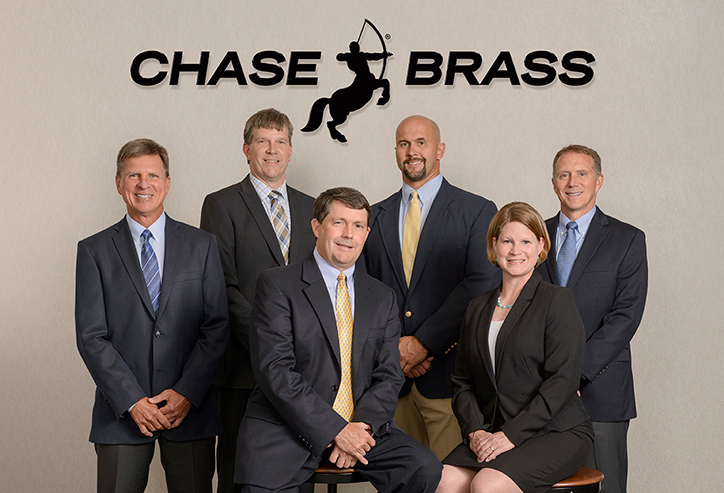Chase History
2016
New Wieland Forgeworks Division is established.
2015
Wieland Chase celebrates its 50th year in business at the Montpelier, Ohio facility.
2014
Global Brass and Copper Holdings, Inc. elects John Wasz CEO; John Walker to continue as non-executive chairman.
2013
Global Brass and Copper Holdings, Inc. is publicly traded on the NYSE under BRSS.
2011
Additional foundry capital investments for alloy production flexibility.
2007
Olin Corporation sells their metal business and Wieland Chase to KPS Capital Partners, LP, which creates a newly formed company, Global Brass and Copper Holdings, Inc. under the leadership of John H. Walker, Chief Executive Officer of GBC.
2005
Chase has license agreement with Sambo Copper Alloy Co., Ltd (now known as Mitsubishi Materials Corporation) to sell ECO BRASS® C69300 and C87850.
Begin production of Green Dot® ECO BRASS® (C69300 alloy) to meet Federal and State lead regulations.
Chase sublicensed California Metal-X, Concast Metal Products, and Ingot Metal Company Limited.
2002
Olin Corporation purchases Wieland Chase Industries.
2001
Leavitt Tube Company is sold to Pinkert Industrial Group, LLC.
2000
Testing is performed in January and production commenced in February at Chase’s new Blue Dot® Brass Rod foundry.
Completion of new extrusion and finish lines.
Chase initiates an interactive business to business (B2B) website.
1999
The new Wieland Chase foundry incorporates state-of-the-art systems technology operated from the newly installed control room overlooking the foundry’s high-tech horizontal casting equipment.
1997
Chase initiates Project 400, a three phase expansion program with the goal of achieving brass production capacity of more than 400 million pounds per year by 2002.
Chase Blue Dot Brass Rod is used in making many products including gauges on oxygen tanks used in the medical industry.
1996
Chase Industries acquires Leavitt Tube, producer of steel tubing.
1995
By the mid-90’s, Wieland Chase was setting records for shipments, year-over-year.
1990
As worldwide demand increases, Chase takes advantage of growing global opportunities.
Martin V. Alonzo steps in as Chairman, President and CEO of Chase Industries and begins a decade of rapid growth for the company.
1982
As capacity increased, Wieland Chase maintained its close focus on being a single product facility.
An important factor throughout the 80’s is the company’s ability to harness new equipment technologies to maximize efficient throughput and achieve optimum quality standards.
1981
The Blue Dot brand name is the predominant, preferred brand and is the standard of quality in the brass rod industry. The Connecticut connection ended for good, and Chase exclusively produced brass rod from the plant near Montpelier, Ohio.
1975
By the mid-1970’s, Chase’s brass is used in majority of brass construction fixtures.
1965
Construction of Chase’s new Montpelier plant is completed with initial capacity of 50 million pounds. The new, state-of-the-art plant begins producing branded Blue Dot ® Brass Rod, recognized for exceeding industry quality specifications and establishing higher standards for brass manufacturing excellence.
1942
Specialties Division is closed, and Chase focuses on profitable commercial and industrial outlets.
1939
During WW II, the government called upon the expertise of Chase executives and technicians to direct the building of a brass mill and to operate it. The mill was constructed on a site adjacent to the Babbitt Road Plant in Cleveland, and was known as the Euclid Case Plant. It produced war materials including shell casings, gun barrel casing and timing devices, such as delay plungers. Chase purchased the mill from the government after the war and named it the Upson Road Plant.
1929
Chase built their third brass mill in Cleveland, Ohio, which was known as the Babbitt Road Plant. They manufactured brass rod, sheet and tubing. Chase Specialties Divisions dazzled consumers with metal novelties.
Chase Metal Works was purchased by Kennecott Copper Corp. and later renamed Wieland Chase & Copper.
Chase becomes a leading supplier of brass components to the fast growing auto industry.
1928
The October 6th issue of the Saturday Evening Post featured an ad introducing Chase’s Centaur logo. Today, the Chase centaur is recognized worldwide as a symbol of product quality and industry leadership.
1927
Chase acquired the U.T. Hungerford Brass and Copper Company and its warehouses.
1921
Brass warehouses and sales offices are operating on both east and west coast.
1918
At the conclusion of WWI, the U.S. Government was Chase’s largest customer.
1910
Henry Chase builds a second brass mill; Chase Metal Works in Waterville, CT.
1896
Henry Sabin Chase succeeds his father as president and introduces the first brass rolling mill in Waterbury, CT in 1900.
The famous Chase Percherons were used to haul freight and materials.
1876
Augustus Sabin Chase joins several local businesses in acquiring the U.S. Button Company. Chase becomes president.
The Company is incorporated as the Waterbury Manufacturing Company and continues to make buttons but expands their brass manufacturing to include lamps, bed, upholstery trimmings, harness ornaments and more.
1837
Hitchcock Button Manufacturing is founded and later renamed U.S. Button Company
We are a brass forgings supplier, machining brass manufacturer, high strength brass manufacturer, brass rod fittings manufacturer, bronze bar manufacturer, brass bar supplier, brass alloy supplier, machining brass suppliers, brass rods manufacturer, brass parts supplier, and a brass machining supplier. We are here for your specific project needs!

